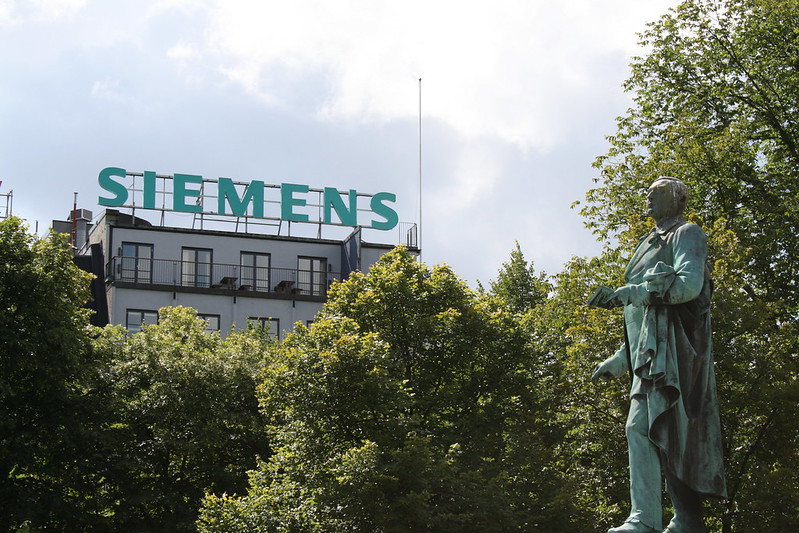When you think of big tech companies, names like Apple, Google, or Microsoft might come to mind first. But there’s another tech giant that’s been around for over 170 years, shaping our world in ways both seen and unseen. That company is Siemens.
Siemens is a global powerhouse in electronics and electrical engineering. They’re involved in everything from power generation and medical imaging to smart buildings and train systems. But how does a company with such a wide range of products and services market itself effectively? That’s what we’ll explore in this deep dive into Siemens’ marketing strategy.
In this post, we’ll look at how Siemens has adapted its marketing approach for the digital age, leveraging content marketing, social media, and innovative campaigns to connect with customers and showcase its technological leadership. We’ll see how they balance promoting specific products with building an overarching brand identity. And we’ll explore how Siemens markets itself differently across various industries and global markets.
By the end of this article, you’ll have a clear picture of what makes Siemens’ marketing strategy tick, along with some inspiring ideas you might apply to your own marketing efforts. Let’s get started!
Overview of Siemens
Before we dive into their marketing strategy, let’s quickly recap what Siemens does. Founded in 1847 in Germany, Siemens has grown into a global conglomerate with over 300,000 employees worldwide. Their business is divided into several main areas:
- Digital Industries: Automation and digitalization for manufacturing and process industries.
- Smart Infrastructure: Intelligent solutions for buildings and energy systems.
- Mobility: Efficient and integrated transportation systems.
- Siemens Healthineers: Medical technology and digital health services.
This diverse portfolio presents unique marketing challenges. Siemens needs to appeal to vastly different audiences, from healthcare professionals to city planners to factory managers. Let’s see how they tackle this challenge.

Siemens’ Overall Marketing Approach
Siemens’ marketing strategy is built on several key pillars:
- Thought Leadership Siemens positions itself as a leader in technological innovation and digital transformation. Their marketing often focuses on big-picture trends and how Siemens is shaping the future of industry, energy, and healthcare.
- Content Marketing The company invests heavily in creating high-quality content that educates and informs its target audiences. This includes whitepapers, case studies, blog posts, and videos that showcase Siemens’ expertise and solutions.
- Digital-First Mindset Recognizing the shift to digital, Siemens has embraced online marketing channels, including a strong social media presence, search engine optimization, and digital advertising.
- Customer-Centric Approach Siemens tailors its marketing messages to specific industries and customer needs, often highlighting how their solutions solve real-world problems.
- Brand Consistency Despite its diverse portfolio, Siemens maintains a consistent brand image across all its divisions, helping to build overall brand recognition and trust.
- Sustainability Focus As sustainability becomes increasingly important to businesses and consumers, Siemens has made it a key part of its marketing message, highlighting its environmentally friendly technologies and practices.
Let’s dive deeper into each of these areas:
Content Marketing Excellence
Siemens’ content marketing strategy is a cornerstone of its overall approach. The company produces a wide range of content types, each designed to engage different segments of its audience at various stages of the buying journey.
One standout example is the Siemens Ingenuity blog . This blog covers topics ranging from artificial intelligence and the Internet of Things to sustainable energy and smart cities. The content is well-researched, engaging, and often includes real-world examples of Siemens technology in action.
For more in-depth content, Siemens produces whitepapers and reports. These often focus on industry trends and challenges, positioning Siemens as a thought leader. For instance, their “Digitalization Productivity Bonus” report explored how digital technologies could boost industrial productivity, subtly showcasing Siemens’ expertise in this area.
Siemens also makes excellent use of case studies. These real-world examples show how Siemens’ solutions have helped specific customers overcome challenges or achieve goals. By focusing on customer success stories, Siemens makes its complex technologies more relatable and demonstrates their practical value.
Digital Marketing Mastery
Siemens has fully embraced digital marketing, recognizing that many of its B2B customers now prefer digital interactions. Their approach includes:
- Social Media: Siemens maintains active profiles on LinkedIn, Twitter, Facebook, and YouTube. Each platform is used strategically to reach different audience segments. LinkedIn, for example, is used for more professional content and thought leadership pieces, while Twitter often features more real-time updates and news.
- Search Engine Optimization (SEO): Siemens invests in SEO to ensure its content ranks well for relevant industry keywords. This helps them capture potential customers who are searching for solutions to specific problems.
- Digital Advertising: The company uses targeted digital ads to reach decision-makers in its key industries. This often includes retargeting campaigns to stay top-of-mind with potential customers who have shown interest in Siemens’ solutions.
- Virtual Events: Especially since the COVID-19 pandemic, Siemens has increased its use of virtual events and webinars to engage with customers and showcase its technologies.
Industry-Specific Marketing
Given Siemens’ diverse portfolio, the company tailors its marketing approach to different industries. This allows them to speak directly to the unique needs and challenges of each sector. Let’s look at a few examples:
Healthcare Marketing
For Siemens Healthineers, the healthcare division, marketing focuses on how their technologies improve patient outcomes and healthcare efficiency. They often use emotional storytelling to connect with healthcare professionals and patients alike.
Campaign Example: “See what others can’t see” This campaign for Siemens’ medical imaging technology used striking visuals to show how their advanced imaging systems can reveal hidden health issues. The tagline “See what others can’t see” emphasized the cutting-edge nature of their technology while appealing to healthcare professionals’ desire to provide the best possible care.
Industrial Automation Marketing
For their Digital Industries division, Siemens markets its automation and digitalization solutions by focusing on increased productivity, efficiency, and competitiveness. They often use technical demonstrations and ROI calculations to appeal to engineers and business decision-makers.
Campaign Example: “Digital Enterprise” This ongoing campaign showcases how Siemens’ digital solutions can transform manufacturing. It includes virtual factory tours, webinars, and interactive tools that allow potential customers to see how Siemens’ technologies could benefit their specific operations.

Smart Infrastructure Marketing
For their Smart Infrastructure division, Siemens emphasizes sustainability, energy efficiency, and smart city solutions. Their marketing often targets city planners, building managers, and sustainability officers.
Campaign Example: “Creating environments that care” This campaign highlights how Siemens’ smart building technologies can create more comfortable, efficient, and sustainable spaces. It includes case studies of smart buildings and cities, as well as interactive tools to help potential customers visualize the benefits of smart infrastructure.
Global Marketing Approach
As a multinational company, Siemens needs to market effectively across diverse global markets. Their approach balances global brand consistency with local market relevance:
- Global Brand Identity
Siemens maintains a consistent global brand identity, using the same logo, color scheme, and overall messaging worldwide. This helps build global brand recognition and trust.
- Localized Content
While the overall brand remains consistent, Siemens creates localized content for different markets. This includes translating materials into local languages and adapting messaging to resonate with local cultural values and business practices.
- Regional Success Stories
Siemens often highlights regional success stories in its marketing. For example, in emerging markets, they might showcase how their technologies are supporting economic development and improving infrastructure.
- Partnerships and Sponsorships
Siemens engages in strategic partnerships and sponsorships that vary by region. For instance, in the United States, Siemens has partnered with Disney to showcase its technologies at Walt Disney World Resort, while in Europe, they’ve sponsored major soccer teams.
- Adapting to Local Digital Landscapes
Siemens adapts its digital marketing strategy to suit local digital ecosystems. For example, in China, they’re active on platforms like WeChat and Weibo instead of Facebook and Twitter.
Campaign Spotlight: “Ingenuity for life”
One of Siemens’ most successful global campaigns was “Ingenuity for life,” launched in 2016. This campaign aimed to unify Siemens’ brand message across all its divisions and global markets.
The campaign showcased how Siemens’ technologies were making a positive impact on people’s lives around the world. It included a series of videos, each set in a different country, showing Siemens technologies in action – from wind farms in Denmark to smart traffic systems in China.
What made this campaign effective was its ability to tell a global story while still feeling locally relevant. Each video was tailored to resonate with local audiences, while still contributing to the overall global message.
The campaign also made clever use of digital channels. In addition to traditional advertising, Siemens created an interactive website where users could explore different Siemens technologies and their impacts. They also encouraged employees and customers to share their own “Ingenuity for life” stories on social media, creating a sense of global community around the brand.
B2B Marketing Focus
While Siemens does have some consumer-facing products, the majority of their business is B2B (business-to-business). This focus shapes their marketing strategy in several important ways:
Longer Sales Cycles
B2B purchases, especially for large-scale industrial solutions, often involve long decision-making processes. Siemens’ marketing is designed to nurture leads over extended periods, providing valuable information at each stage of the buying journey.
Multiple Decision Makers
B2B purchases typically involve multiple stakeholders. Siemens creates targeted content for different roles – from technical specialists to C-suite executives – ensuring they address the concerns of all decision-makers.
Emphasis on ROI and Total Cost of Ownership
For B2B customers, the financial impact of a purchase is crucial. Siemens’ marketing often includes detailed ROI calculations and emphasizes the long-term value of their solutions, not just the upfront costs.
Building Relationships
In B2B markets, strong relationships are key. Siemens invests in account-based marketing for key clients, creating highly personalized marketing approaches for their most valuable customers.
Thought Leadership
By positioning itself as a thought leader in its various industries, Siemens builds credibility with B2B buyers who are looking for knowledgeable, reliable partners.
Campaign Example: “Customer First”
This B2B-focused campaign showcased Siemens’ commitment to customer success. Instead of highlighting specific products, the campaign featured stories of how Siemens worked closely with customers to solve complex challenges.
The campaign included a series of video case studies, each telling the story of a different customer partnership. These were shared on LinkedIn and other B2B-focused platforms, as well as at industry trade shows.
What made this campaign effective was its focus on customer outcomes rather than product features. By showing how Siemens becomes a true partner to its customers, the campaign appealed to B2B buyers looking for more than just a vendor.
Key Takeaways from Siemens’ Marketing Strategy
As we wrap up our exploration of Siemens’ marketing approach, let’s highlight some key lessons that marketers in any industry can apply:
- Consistent Brand, Diverse Messages
Siemens maintains a consistent overall brand while tailoring its messaging to different industries and customer needs. This allows them to benefit from broad brand recognition while still speaking directly to specific customer pain points.
- Content is King
Siemens’ investment in high-quality, informative content positions them as a thought leader and trusted advisor to their customers. This content-first approach is particularly effective in B2B marketing, where customers often seek in-depth information before making purchasing decisions.
- Embrace Digital, But Don’t Forget Traditional Channels
While Siemens has fully embraced digital marketing, they still use traditional channels like trade shows and print advertising where appropriate. The key is to create an integrated marketing approach that reaches customers through their preferred channels.
- Focus on Outcomes, Not Just Features
Siemens’ marketing often focuses on the outcomes their technologies enable – like improved patient care or more sustainable cities – rather than just listing product features. This approach helps customers envision the real-world impact of Siemens’ solutions.
- Global Reach, Local Relevance
Siemens’ ability to maintain a consistent global brand while creating locally relevant marketing content is crucial for their success as a multinational company.
- Long-Term Vision
Many of Siemens’ marketing initiatives focus on big-picture trends and future challenges. This forward-looking approach positions Siemens as a partner for the future, not just a vendor for today’s needs.
- Sustainability as a Core Message
By making sustainability a key part of their marketing message, Siemens aligns itself with a growing global concern and positions its technologies as solutions to some of the world’s most pressing challenges.
What Makes Siemens’ Marketing Strategy Special?
Siemens’ marketing strategy offers valuable lessons for marketers in both B2B and B2C sectors. By combining thought leadership, digital savvy, and a customer-centric approach, Siemens has built a powerful global brand that resonates across diverse industries and markets.
As technology continues to evolve and shape our world, Siemens’ marketing approach shows how a company can position itself at the forefront of change, using marketing not just to sell products, but to tell a larger story about innovation and progress.
Whether you’re marketing high-tech solutions or everyday products, the principles behind Siemens’ success – consistent branding, valuable content, customer focus, and a vision for the future – can help inspire and guide your own marketing efforts.

